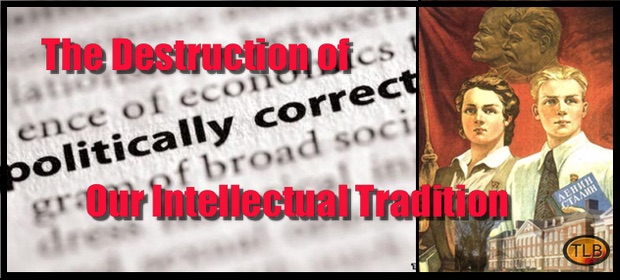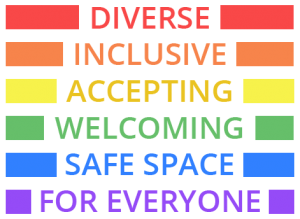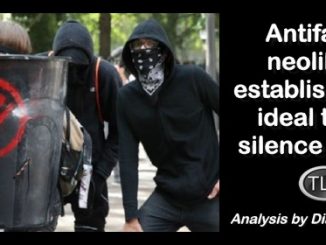
Commissars in Our Universities
PHILIP CARL SALZMAN
“The term ‘politically correct’ was coined in the late 1920s by the Soviets and their ideological allies around the world to describe why the views of certain of the party faithful needed correction to the party line.[1]
Totalitarian movements and totalitarian societies strove to insure uniformity of thought:
“Professor Frank Ellis at the University of Sheffield noted the term ‘political correctness’ was first used in the late 19th to the early 20th century when Vladimir Lenin began his rise to power. Ellis said that Marxist-Leninists and Maoists placed a heavy preeminence on being ideologically correct, both politically and theoretically. Essentially, a ‘forum for discussion,’ as Ellis described it, would impede the revolutionary spirit needed to upend the social order.”[2]
Leftist intellectuals were in the forefront of advancing communist ideology. “As pointed out by author William Lind, it was the intellectuals, such as Georg Lukacs, who believed culture needed to be rooted out before it could be replaced by a Marxist one. To do so, ‘critical theory’ came to fruition with the goal of destroying what it perceived to be old ways of thinking.”[3] The goal was to replace support for liberal individualism and freedom with collectivism and obedience, and correspondingly to replace capitalism with communism.
The Soviet Union assigned political officers to the military after the Russian Revolution. “The organization of the Soviet military underwent a series of transformations since its inception in 1917, including introductions of at least two specialized political officer positions—the politruk, also called political director, and the pompolit, also called deputy commander for political affairs. In historic and cultural contexts, these positions collectively are referred to as commissars, though this phrase often refers only to the politruk.”[4]
Political officers are assigned to units in the Chinese People’s Liberation Army (PLA):
The three levels of political officers who serve as unit leaders (zhuguan) and deputy leaders are as follows (People’s Liberation Army Air Force 2010, Chapter 6, NASIC; China’s National Defense 2002)[5]:
- Political commissars (zhengwei) are assigned to all organizations at the regiment level and above;
- Political directors (jiaodaoyuan) are assigned to all battalion-level organizations;
- Political instructors (zhidaoyuan) are assigned to all company-level organizations.
The three levels of political officers above have basically the same key responsibilities:
- Implementing decisions made by the party committee;
- Instilling party discipline among party members;
- Providing political education to the troops within their organization;
- Working with other components of the political work system.
More explicitly, the commissar’s tasks[6] were
- Spreading Marxism-Leninism-Mao Zedong Thought among the rank and file
- Enhancing political consciousness
- Guaranteeing the CCP’s absolute leadership over the PLA
- Abiding by CCP’s line, policy
- Strengthening unity internally and externally enhancing combat capability of the troops
Commissars are not limited to the military. They are also embedded in other important institutions. Here is an example from international business:
“The Chinese were effectively demanding that global corporation shift the entire Asian business out of their Indian operation and move it to China. All this might appear par for the course in the internal politics of multinational corporations. What was different here was that two of the Chinese executives involved were ranking members of the Communist Party of China – commissars, as they used to be called – and they were not merely making a sales pitch. The Westerners noticed a distinct ‘or else…’ in the proposals they were hearing from the Chinese colleagues.”[7]
In Chinese schools, the head teacher plays the role of the commissar:
“In the organizational structure of a Chinese classroom, the head teacher is responsible for 50 students’ study, behavior, and thought for three years. This organization is repeated from kindergarten to university, and from Beijing to Tibet. Back when the Communist Party was a revolutionary movement, a political commissar was responsible for the discipline and orthodoxy of each Party cell, and a ‘head teacher’ is basically the political commissar of a cell of 50 students. In Chinese high schools, having students study hard is not enough – correct thinking is the ultimate goal.”[8] [emphasis added]
Universities in the English-speaking world, and in particular universities in North America, have in the last decades committed to an ideology as the basis of their functioning. Our political correctness is not the Marxism-Leninism of the Soviet Union, or the Maoism of China, but a kind  of neo-marxism that is usually called “social justice” ideology.[9]It stresses equality above all other values, and deals with people as members of categories or collectivities. Its guiding operational principle is “representation” on the basis of statistical presence in the general population.
of neo-marxism that is usually called “social justice” ideology.[9]It stresses equality above all other values, and deals with people as members of categories or collectivities. Its guiding operational principle is “representation” on the basis of statistical presence in the general population.
To illustrate, here is the “social justice” creed as set out by “Universities Canada” (previously “The Association of Universities and Colleges of Canada”)[10]:
- We believe our universities are enriched by diversity and inclusion. As leaders of universities that aspire to be diverse, fair and open, we will make our personal commitment to diversity and inclusion evident.
- We commit our institutions to developing and/or maintaining an equity, diversity and inclusion action plan in consultation with students, faculty, staff and administrators, and particularly with individuals from under-represented groups [1]. We commit to demonstrating progress over time.
- We commit to taking action to provide equity of access and opportunity. To do so, we will identify and address barriers to, and provide supports for, the recruitment and retention of senior university leaders, university Board and Senate members, faculty, staff and students, particularly from under-represented groups.
- We will work with our faculty and staff, search firms, and our governing boards to ensure that candidates from all backgrounds are provided support in their career progress and success in senior leadership positions at our institutions.
- We will seek ways to integrate inclusive excellence throughout our university’s teaching, research, community engagement and governance. In doing so, we will engage with students, faculty, staff, our boards of governors, senates and alumni to raise awareness and encourage all efforts.
- We will be guided in our efforts by evidence, including evidence of what works in addressing any barriers and obstacles that may discourage members of under-represented groups to advance. We commit to sharing evidence of practices that are working, in Canada and abroad, with higher education institutions.
- [1] Under-represented groups include those identified in the federal Employment Equity Act – women, visible minorities, Aboriginal peoples, and persons with disabilities – as well as, but not limited to, LGBTQ2+ people and men in female-dominated disciplines.
This official statement is quite typical of statements by governments, academic associations, and universities.[11]They all make the unwarranted and unjustified ethical assumption that every organization and every unit must reflect the presence of various groups and categories in the general population. They all argue that diversity “enriches” universities, but rarely explain how, and when explanations are given, they are unsubstantiated by or contrary to evidence.[12]
They falsely hint or explicitly state that some categories are “underrepresented” due to bigotry and discrimination, and fail to present convincing evidence to support this assertion.[13] Finally, they recommend that special favor and privilege be granted to “underrepresented minorities,” thus justifying  discrimination on the race, gender, sexual preference, ethnicity, etc.[14] In other words, the objective of these “social justice” agendas is to include people in some categories while excluding people in other categories. “Inclusion” is only for favored categories of people.
discrimination on the race, gender, sexual preference, ethnicity, etc.[14] In other words, the objective of these “social justice” agendas is to include people in some categories while excluding people in other categories. “Inclusion” is only for favored categories of people.
Universities seek practical methods for implementing “social justice” preferences to advance so-called “underrepresented minorities,” and to reduce the presence of people in undesirable categories, particularly white heterosexual males. This is how Universities Canada sets out the plan[15]:
Capacity building and culture change
Expected outcome
Increased capacity at Canadian universities to integrate equity, diversity and inclusion in their teaching, research and governance.
Supporting actions
-
Build institutional capacity to support an equitable, diverse and inclusive organizational culture.
-
Build institutional capacity and culture to recruit diverse students, staff, faculty and administrators, and support their success.
-
Build institutional capacity and culture to integrate equity, diversity and inclusion considerations in research, teaching and learning.
Who is responsible for carrying out these plans? A new type of bureaucrat has been invented to carry the burden of change to a politically correct culture in universities: the “diversity and inclusion” officer. There are usually multiple “diversity and inclusion” officers, ranging from vice president positions to positions in smaller units. For example, McGill University proudly announces “the creation of several new positions at McGill during the last two years, notably: the Senior Employment Equity Advisor, Senior Equity & Inclusion Advisor, and Equity Facilitator.” This is in addition to the Associate Provost (Equity and Academic Policy).[16]
The job of “diversity and inclusion” commissars is to impose and enforce politically correct thought and action. It is common that these political commissars are given powers of judge and jury, and powerful sanctions are at their disposal. For example, if a professor expresses opinions contrary to those of “social justice diversity and inclusion,” he or she can be sent for re-education, usually in courses given by external diversity “experts.” Or, even more “inclusive” are mandatory “diversity” courses for all professors.[17]
Politically incorrect professors, even those tenured and popular with students, are vulnerable to pressure and ultimately to dismissal. A McGill science professor who expressed incorrect views about feminism—a central component of “right thinking”—was warned by his dean to  remain silent. In another case, Acadia University psychology Professor Rick Mehta (pictured), although having claims to being a “visible minority” as we Canadians like to say, just would not get with the politically correct program. He called multiculturalism a “scam,” and was “accused as well of ‘denying the wage gap between men and women and dismissing the Truth and Reconciliation Commission as a vehicle for ‘endless apologies and compensation.’” Furthermore, “Professor Mehta had offended the feminist establishment at Acadia by arguing for objective academic standards and against privileges for self-proclaimed victim groups.”[18] His university informed him that “The University has a legal responsibility to provide an environment free from discrimination, sexual harassment, and personal harassment,” which apparently means that incorrect opinion, and thus diversity of opinion, is forbidden. Then Acadia University fired Professor Mehta.[19]
remain silent. In another case, Acadia University psychology Professor Rick Mehta (pictured), although having claims to being a “visible minority” as we Canadians like to say, just would not get with the politically correct program. He called multiculturalism a “scam,” and was “accused as well of ‘denying the wage gap between men and women and dismissing the Truth and Reconciliation Commission as a vehicle for ‘endless apologies and compensation.’” Furthermore, “Professor Mehta had offended the feminist establishment at Acadia by arguing for objective academic standards and against privileges for self-proclaimed victim groups.”[18] His university informed him that “The University has a legal responsibility to provide an environment free from discrimination, sexual harassment, and personal harassment,” which apparently means that incorrect opinion, and thus diversity of opinion, is forbidden. Then Acadia University fired Professor Mehta.[19]
In another now infamous case, Wilfred Laurier University graduate student and teaching assistant Lindsay Shepherd showed in her course a TVOntario current events program which featured a discussion of gender and gender pronouns by Professor Jordan Peterson of the University of Toronto.  Shepherd was called into a meeting with her supervisor, the head of her academic program, and the acting manager of the University’s Diversity and Equity Office. Shepherd was told that playing the Peterson clip was like “neutrally playing a speech by Hitler.” Peterson’s arguments were alleged to be “‘counter to the Canadian Human Rights Code, and that what had happened in class had been contrary to the university’s Gendered and Sexual Violence Policy; the manager [of the University’s Diversity and Equity Office] offered the view that it might have violated the Ontario Human Rights Code’.” The official commissars of the Diversity ad Equity Office, and the professors, were merely trying to correct Shepherd’s politically incorrect belief in the validity of a diversity of opinion, and the value of hearing different sides to issues.[20] Shepherd had prudently recorded this meeting, and released it to the Canadian national press, where it was widely reported. In the face of public outcry against the suppression of academic freedom and free speech, the University and one of the professors backed down and wrote letters of apology. Shepherd is suing the University, as is Peterson.[21]
Shepherd was called into a meeting with her supervisor, the head of her academic program, and the acting manager of the University’s Diversity and Equity Office. Shepherd was told that playing the Peterson clip was like “neutrally playing a speech by Hitler.” Peterson’s arguments were alleged to be “‘counter to the Canadian Human Rights Code, and that what had happened in class had been contrary to the university’s Gendered and Sexual Violence Policy; the manager [of the University’s Diversity and Equity Office] offered the view that it might have violated the Ontario Human Rights Code’.” The official commissars of the Diversity ad Equity Office, and the professors, were merely trying to correct Shepherd’s politically incorrect belief in the validity of a diversity of opinion, and the value of hearing different sides to issues.[20] Shepherd had prudently recorded this meeting, and released it to the Canadian national press, where it was widely reported. In the face of public outcry against the suppression of academic freedom and free speech, the University and one of the professors backed down and wrote letters of apology. Shepherd is suing the University, as is Peterson.[21]
In many universities, diversity and inclusion officers have been charged with investigating complaints of sexual impropriety and sexual violence, in the U.S. under Title IX. In most cases, these officers are women, and dedicated feminists. They have been instrumental in prosecuting and persecuting innocent males falsely accused.[22] In this enterprise in injustice, university administrations have relentlessly backed their diversity officers, even when the accused has been vindicated by independent experts.[23]
Where are we now? Our governments, academic agencies, and universities have rejected the liberal emphasis on individual academic merit and achievement in admissions and hiring, and replaced it with the illiberal principle of proportional representation of members of census categories. In practice, this means that favoring and benefiting members of alleged “underrepresented” minorities, such as females, people of color, indigenous people, homosexuals and transsexuals, and ethnics such as Muslims; and that the same time they disfavour and exclude members of alleged “overrepresented” categories, such as males, whites, heterosexuals, Christians, Jews, and Asians. But do not think this is reverse sexism, reverse racism, and bigotry; it is what today passes for “social justice.”
In aid of this “social justice” agenda, various falsehoods are asserted, such as that “multiculturalism” is not a sociological oxymoron[24], but the highest morality; that all cultures are equally good and valuable[25]; that biology does not influence our social roles and behavior (except for homosexuals)[26]; that females never lie and should always be believed[27]; that ideas of merit and achievement are white male supremacism; and that a race-blind policy is racist, as is the statement that “all lives matter.” As it is forbidden to challenge these falsehoods, and anyone doing so will be attacked by student thugs or administration enforcers, and probably both, free speech, the marketplace of ideas, and diversity of opinion no longer exist in our universities.
University administrations are vehemently committed to “social justice” ideology, and they have appointed a series of “diversity and inclusion” commissars to serve as enforcers to suppress any politically incorrect opinions. These enforcers hold the future of any student or employee in their hands, and will destroy any student or employee who expresses forbidden truths, or questions the “social justice” agenda. The totalitarian communist regimes have proven to be such a very useful example for our universities to follow.




